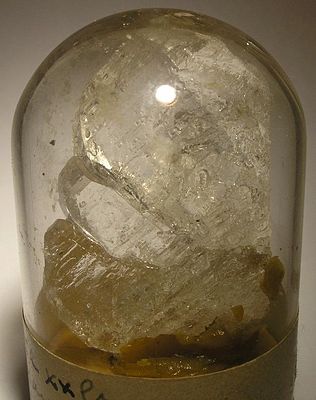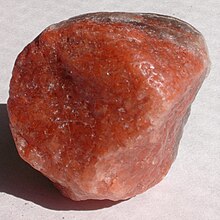Carnallite
| Carnallite | |
|---|---|
| Carnallite from the Lower Saxony potash plant near Wathlingen (size: 4 cm × 2.7 cm × 1.3 cm) | |
| General and classification | |
| chemical formula | KMgCl 3 • 6H 2 O |
|
Mineral class (and possibly department) |
Halides |
|
System no. to Strunz and to Dana |
3.BA.10 ( 8th edition : III / C.08) 01/11/02/01 |
| Similar minerals | Halit , Sylvin |
| Crystallographic Data | |
| Crystal system | orthorhombic |
| Crystal class ; symbol | orthorhombic-dipyramidal; 2 / m 2 / m 2 / m |
| Space group | Pbnn (No. 52, position 3) |
| Lattice parameters | a = 9.55 Å ; b = 16.12 Å; c = 22.47 Å |
| Formula units | Z = 12 |
| Physical Properties | |
| Mohs hardness | 1 to 2 |
| Density (g / cm 3 ) | measured: 1.602; calculated: 1.598 |
| Cleavage | no |
| Break ; Tenacity | shell-like |
| colour | colorless, white, yellow, red, blue |
| Line color | White |
| transparency | transparent to translucent |
| shine | Glass gloss to fat gloss |
| radioactivity | hardly measurable |
| Crystal optics | |
| Refractive indices |
n α = 1.465 to 1.466 n β = 1.474 to 1.475 n γ = 1.494 to 1.496 |
| Birefringence | δ = 0.029 to 0.030 |
| Optical character | biaxial positive |
| Axis angle | 2V = 70 ° (measured), 66 ° (calculated) |
| Other properties | |
| Chemical behavior | Easily soluble in water |
| Special features | strong fluorescence |
Carnallite is a mineral from the mineral class of halides . It crystallizes in the orthorhombic crystal system with the chemical composition KMgCl 3 · 6H 2 O and is therefore chemically seen a hydrous potassium - magnesium - chloride or in other words a water-containing, equimolar mixture of potassium chloride and magnesium chloride with a molecular weight of 277.85.
Carnallite often develops pyramidal or tabular and rarely by twinning pseudo-hexagonal crystals with glass-to-fat-like luster on the surfaces, but also comes in the form of granular aggregates before. In its pure form, carnallite is colorless and transparent. However, due to multiple light refraction due to lattice construction defects or polycrystalline training, it can also be translucent white and, due to foreign admixtures, take on a yellow, red or blue color.
Etymology and history
Carnallite was first found and described in 1856 in the potash district of Staßfurt in Saxony-Anhalt by Heinrich Rose (1795–1864). He named the mineral after the Prussian mining engineer Rudolf von Carnall (1804–1874).
classification
Already in the outdated, but partly still in use 8th edition of the mineral classification according to Strunz , carnallite belonged to the mineral class of "halides" and there to the division of "double halides, containing water", where it formed an independent group together with koenenite , redikortsevit and tachyhydrite .
In contrast , the 9th edition of Strunz's mineral systematics , which has been in effect since 2001 and is used by the International Mineralogical Association (IMA), classifies carnallite under the category of “simple halides with H 2 O”. This is further subdivided according to the molar ratio of cations (mostly metals, M) to anions (X), so that the mineral can be found in the sub-section "M: X = 1: 1 and 2: 3" according to its composition, where it forms the unnamed group 3.BA.10 as the only member .
The systematics of minerals according to Dana also assigns carnallite to the class of "halides", but in the more finely subdivided division of "complex halides - aluminum fluorides". Here he is to be found as the only member of the unnamed group 11.01.02 within the subdivision of “ Complex halides - aluminum fluorides with (A) m B (X) 3 ”.
Crystal structure
Carnallite crystallizes orthorhombically in the space group Pbnn (space group no. 52, position 3) with the lattice parameters a = 9.55 Å , b = 16.12 Å and c = 22.47 Å as well as 12 formula units per unit cell .
properties
Carnallite has a glossy glass finish when fresh and dry, but becomes matt when damp. It consists of potassium chloride , magnesium chloride and water as well as traces of rubidium chloride , cesium chloride and bromine as bromide (up to approx. 300–400 ppm).
Particularly noteworthy are its strong fluorescence , its easy solubility in water and its pungent taste. Also dissolves the mineral after some time in the air with precipitation of sylvite . A squeaking noise is produced when the tip of a knife or spatula is pressed in and turned.
Modifications and varieties
Carnallite is given a reddish color by adding large amounts of microscopic flakes of hematite .
Education and Locations
Carnallite is formed by evaporation together with other potash salts and magnesium salts as the last phase of the salt cycle . During diagenesis , it is transformed into sylvin .
As a rare mineral formation, carnallite has so far only been found in a few sites, with around 100 sites being known to date (as of 2015). In addition to its type locality in Staßfurt in Saxony-Anhalt, the mineral was found in Germany, among others, in the potash salt mines of Heringen and Philippsthal in the Hessian Werra Valley, in several mines in Lower Saxony , in Röblingen am See , Bernburg (Saale) and Egeln in Saxony-Anhalt as well as near Bleicherode and Bad Salzungen in Thuringia.
Carlsbad in the US state of New Mexico is also known for its extraordinary carnallite finds, where crystals up to 4 cm in size came to light.
Other sites include Entre Ríos in Bolivia; Sergipe in Brazil; Afar in Ethiopia; several sites in the Chinese province of Qinghai ; Surtsey near Iceland; several sites on Sicily in Italy; New Brunswick , Québec and Saskatchewan in Canada; in the Aksai Valley in the Aktobe region of Kazakhstan; at Mount Ruapehu in New Zealand; Winterswijk and Veendam in the Netherlands; Inowrocław and Kłodawa in Poland; Loulé in Portugal; in the Russian regions of Eastern Siberia , Saratov Oblast and Urals ; Bages in Spain; Kalush (Ivano-Frankivsk) in Ukraine, Humberside and North Yorkshire (England) in the United Kingdom, and several regions of Arizona , Colorado , Michigan and Utah in the United States (USA).
use
The extraction of bromine from carnallitic waste liquors is no longer considered economical.
Carnallite is one of the most important potash salts and serves on the one hand as a fertilizer and on the other hand as a raw material for the production of magnesium . Carnallitic crude salts, however, have the disadvantage compared to Sylvinitic crude salts (e.g. hard salt ) that final liquors containing a large amount of magnesium salt are formed during processing. Most of the alkalis can only be partially disposed of by pressing them into porous rock layers, the rest is discharged into nearby rivers. For this reason, potash salt deposits with sylvinite (rock made from sylvin, halite, etc.) are preferred over carnallitite (rock made from carnallite, halite, etc.). In addition, carnallite is much less stable in mining than rock salt, sylvinite or hard salt, because it is attacked by saturated sodium chloride lye with the formation of sylvine and sodium chloride lye that is rich in magnesium.
See also
literature
- Heinr. Rose: About the carnallite . In: Annals of Physics and Chemistry . tape 98 , 1856, pp. 161–163 ( rruff.info [PDF; 227 kB ; accessed on May 21, 2017]).
- Friedrich Klockmann : Klockmann's textbook of mineralogy . Ed .: Paul Ramdohr , Hugo Strunz . 16th edition. Enke, Stuttgart 1978, ISBN 3-432-82986-8 , pp. 492 (first edition: 1891).
- EO Schlemper, PK Sen Gupta, Tibor Zoltai: Refinement of the structure of carnallite, Mg (H 2 O) 6 KCl 3 . In: American Mineralogist . tape 70 , 1985, pp. 1309–1313 ( rruff.info [PDF; 576 kB ; accessed on May 21, 2017]).
Web links
- Mineral Atlas: Carnallite (Wiki)
- Webmineral - Carnallite
- RRUFF Database-of-Raman-spectroscopy - Carnallite
- American-Mineralogist-Crystal-Structure-Database - Carnallite
Individual evidence
- ↑ Webmineral - Carnallite (English)
- ↑ a b c d Hugo Strunz , Ernest H. Nickel : Strunz Mineralogical Tables. Chemical-structural Mineral Classification System . 9th edition. E. Schweizerbart'sche Verlagbuchhandlung (Nägele and Obermiller), Stuttgart 2001, ISBN 3-510-65188-X , p. 156 .
- ↑ Hans Jürgen Rösler : Textbook of Mineralogy . 4th revised and expanded edition. German publishing house for basic industry (VEB), Leipzig 1987, ISBN 3-342-00288-3 , p. 364 .
- ↑ Carnallite . In: John W. Anthony, Richard A. Bideaux, Kenneth W. Bladh, Monte C. Nichols (Eds.): Handbook of Mineralogy, Mineralogical Society of America . 2001 ( handbookofmineralogy.org [PDF; 482 kB ; accessed on May 21, 2017]).
- ↑ a b c d e Mindat - Carnallite
- ↑ Thomas Witzke : The discovery of Carnallite at www.strahl.org
- ↑ Michael Götzinger, Eugen Libowitzky: Mineralogy and commodity customer. Part 2: Minerals of rocks and mineral raw materials . S. 17 ( univie.ac.at [PDF; 323 kB ; accessed on May 21, 2017]).
- ↑ Mindat - Number of locations for Carnallite
- ↑ Petr Korbel, Milan Novák: Mineral Encyclopedia (= Dörfler Natur ). Nebel Verlag, Eggolsheim 2002, ISBN 978-3-89555-076-8 , p. 68 .
- ↑ Find location list for carnallite in the Mineralienatlas and Mindat


